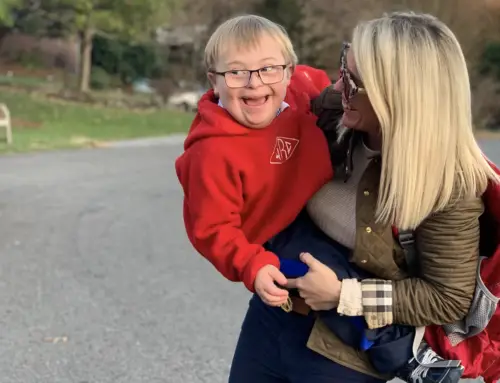We pulled up to the elementary school dressed for success with our outline typed up and tucked safely in a manila folder. The rest of our team was already seated and making nervous small talk as we were buzzed into the office. Our team consisted of John’s BCBA and an educational advocate that we had hired to lead us into war. The nervous butterflies I was experiencing morphed into giant moths as we were led into the board room. The board room usually evoked this type of emotion from me, but today was different. Today there were at least 8 opponents seated at the table ready for “Team John vs. ‘the County.’” Yes, we were outnumbered, but our graphs, charts, data, and dialogue had all been well rehearsed and we felt confident…

If this battle ground reminds you of a place you have once been or dread visiting someday, you know what it’s like to attend an IEP (Individualized Educational Plan) meeting. To clarify, this is what an IEP meeting feels like after you’ve exhausted all the resources available at your child’s school. Before you misunderstand my analogy, I want to emphasize that the IEP process is important, and for most families, it is also a positive process. However, when placement is an issue and an IEP doesn’t fit the child’s needs in his current environment, the IEP process becomes difficult. Obviously not all IEP meetings require a fully equipped battalion. The IEP meetings I attend at John’s current school are informational and almost fun. And THAT is saying something. We are all on the same page and are working together as one team. Some of the IEPs that I attended when John was younger, though, felt like a waste of time — half of my day to be exact — and a whole lot of paper. I often felt like I had no choice but to check the box they wanted me to. In actuality, I always had a choice, I just didn’t have the right words to back my feelings, and truthfully, I didn’t have the guts.
Let me lay out the complexity of my timidity. I have a habit of avoiding hard conversations and often neglect to say anything that might make others uncomfortable. Added to this difficulty is the issue of the teacher. I like to develop a healthy working relationship and open lines of communication with all of John’s teachers. Many of his past teachers were undertrained (no fault of their own), underpaid, kind, and well meaning, which only contributed to the awkwardness of the equation. Danny and I knew that if we really wanted to make something happen we would need to bring in reinforcements. Danny is much better at talking about the hard issues, but in the IEP world, he didn’t have the right words either.
On this particular morning we really wanted to make something happen. We were after the penultimate goal in the special needs public education world: private school funding through the county. It’s the next to last stop for many parents in difficult situations. Our advocate came highly recommended and had already taught us the importance of our language. Words like “ideal” were taboo and were replaced with words like “appropriate.” We were there to prove that John was not making appropriate progress in his goals (that line came right out of the state law) and required a one-on-one environment where his aggressive behaviors could be successfully managed. In plain English, he needed eyes on him all the time, and if necessary, he needed to be restrained in order to keep everyone safe.
I wish I could say that with all of our preparation and prayer, we had immediate success. We didn’t. What we were hoping would be just a few punches thrown at the neighborhood playground turned into a saga that makes The Lord of the Rings trilogy pale in comparison. But each meeting did bring us a little closer to our goal. Blood, sweat, and tears were all included. Well, maybe not blood, but sweat and tears were. Tears were shed by me, by Danny, and by John’s teacher. It was incredibly hard to say what needed to be said. It wasn’t personal, but I’m sure it felt personal to her. The running dialogue in my head was, “I’m saying this for John…I’m doing this for John…just think of John.” Even with my motivation in the right place, it was still extremely difficult. This is one of the many reasons I admire Lindsay so much, and all of the other parents out there who are strong and capable advocates for their children. It’s not easy, but you do what you need to do for your child’s happiness and well being.
Ultimately, we were successful, and John is now at a school that seems to be created for him. It fits his needs like a glove, and I can confidently say that the money, time, and stress was all worth it. What made the difference for us was that we hired an advocate who had decades of experience. As a side note, I know talking about money is tacky, but our point in sharing here is to inform. We were given an estimate of $5,000 to go through the process, and due to the difficulties described here, the final bill was in the neighborhood of $10,000. Instead of just money well spent, it feels more accurate to say a LOT of money – well spent. We also had a BCBA who had concrete data of John’s behaviors at home. And most importantly, we knew that a private school placement (the only place for 1:1 supervision) was the only place where he could be safe and make any academic progress.
It may look like I’m painting a dark picture of public school employees. That is absolutely not my intention. I have nothing but respect and admiration for individuals who choose to work day in and day out with special needs kids through speech, OT, and various other modalities. I have worked in school settings myself, and it’s rewarding and exhausting work. I respect people who work as school administrative employees, as well individuals who support special needs education as a county employee. We encountered a few individuals who were difficult to work with during the process of transitioning John into a private school, but ironically, we have had good relationships with our county liaisons following our experience to get proper placement.
What may seem like an exaggerated story of struggle to some, may also feel too familiar to many of you. You also know that the decisions made at an IEP meeting are just the first obstacle to conquer, and those decisions don’t always lead to a happy ending. Luckily, I was saved from myself during this process. I had my heart set on a school that I thought was perfect, there were 4 schools that I had blacklisted, and there was a school that I thought of as an OK alternative. I wanted this school for John more than a high school senior wants admission to Harvard. You can understand how devastated I was then, when they told us they didn’t have a place for a child with his magnitude of behaviors. This story does have a happy ending though. My alternate school turned out to be the best place for John and for our whole family.
At the conclusion of our most painful IEP meeting during “John vs. the county,” an unnamed attendee turned to me and whispered that the meeting had been more uncomfortable than his last colonoscopy. Maybe he was right. But ya know what? A child’s well-being and educational potential was in our hands, and we had no choice but to make the right choice, and it was crystal clear what that choice was. It’s OK that we felt uncomfortable.
So pat yourself on the back if you’ve sat through an uncomfortable IEP meeting, and I’m not referring to your backside falling asleep. If you’ve sat through a rough one, it means you care, and you want your child to have an “appropriate” educational experience. If you’re timid like I was, don’t hesitate to bring in extra support. Follow your instinctive gut, but also keep an open mind, and don’t get your heart set on only one possible outcome like I did. If you’re interested in more specific details of our experience, don’t hesitate to reach out. And please, share your experiences with us. We have so much to learn from this community.







Great job helping John. That must have been so hard!
Well done. Thank you for sharing!
very encouraging thank you for sharing.
My child is now 15 soon to be 16. Diagnosed with autism at 3. Due to lack in services I say he’s under diagnosed & has other comorbidities included.. (ODD, DID, Anxiety/depression.. emotional disturbance.. Auditory processing disorder, it’s really hard to sus out what but I know he’s definitely struggling with more than a school can see.) I have been bullied out of our only school district to homeschool bc of his behavioral issues. Rather than following regulation, they kind of underhandedly just made my guilt of him being a “problem” to the point I took him out bc I couldn’t face the constant reporting (verbal not in writing..) to saying come get your kid.. with no documentation of what he did or suspensions, ect. It wasn’t until the pandemic, I researched and realized I have definitely faced a situation with my child that I carried no knowledge of the laws and rights of my student. Now as my kiddos sleep, I’m studying.. researching and trying to grow a backbone bc it was done so easily bc I hate confrontation nor do I want to be viewed as “problematic” (yet I have been THAT parent for much of his life without law and rights to back up my “this isn’t right” statements..) I’m glad to have come across this post bc I am set to have a IEP assessment review meeting and I definitely am a ball of nerves!! I want to fight (metaphorically bc I don’t want to be combative lol) but I’m definitely wanting to seek changes (they’ve never accepted my input in his IEPs to this day..) with the law on my side, I am ready to request he get the best supports to thrive. Thank you for making me feel like I am not alone and that individuals are out there facing these what feel like trivialities bc you feel unheard, underserved. Thank you.. I feel understood.
We are with you and hope that your meeting goes well. One big lesson for us was to never use words like “ideal” or “best” because schools are committed to such terms. But if you use terms like “inadequate”, “not meeting his basic needs”, “unsupportive”, etc it carries much greater weight because there is a bar that schools are held to and terms like these ring home – even if that’s the same idea as what you’re trying to communicate. Unfortunately in these confrontational and unfortunately sometimes combative environments, exact wording makes a huge difference between addressing an issue and ignoring it and moving on to the next. Good luck, you can do it!